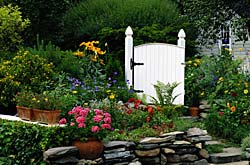How to Start a Successful Garden
See if We Have Top-Rated
Landscaping Contractors in Your Area

The key to successful gardening is preparedness. Whether you're thinking about starting a garden or have been tended your own garden for a few years, the best thing you can do is plan ahead. Start your garden now. Waiting until the first day of spring to begin your garden puts you behind schedule. Since you'll need shovels, hoes, pruners, and other gardening tools, go to the hardware store now and beat the rush. Make sure these tools are sharpened or, better yet, learn how to sharpen them yourself. Don't sit on the couch and say that you'll start a garden this year, go ahead and start one.
Landscape Professionals
If you think you may want to take on a slightly more ambitious project or specific questions about a certain aspect of your lawn or garden, call a landscape professional. Winter is the down season for landscapers and many of them may be happy to provide free consultations if you call them early enough. Plus, if you decide you need a landscaper too late, you may get waitlisted.
If you need to put in new lawn, make arrangement for early sod delivery or discover when the sod will be delivered to garden centers for the season. This will help ensure you get fresh, wet sod. Don't accept any sod rolls that have yellowed turf or dry roots.
Other Things You Can Do Now
Most people know one of the most important things to making a garden successful is good soil. For the best results, you should have your soil tested for around $800 to determine its exact mineral content. Instead of choosing a general fertilizer this will allow you to find a fertilizer tailored to the specific deficiencies of your soil. The content and quality of your soil can change from year to year so its best if you test your soil each year. The cost of a soil test varies from state to state, but a basic soil test can often cost less than $10.
Before you spring, you can also create a space for garden storage. More than just a place to throw your gardening tools, a specific storage area will give you a place to put gardening chemicals. The storage should be locked to keep your children and pets away from the chemicals and tools. Also, remember to check the chemicals every year and discard any that are out-of-date.
Need a little help in the garden? Use this link to hire a local
Gardener
Now That It's Spring
When the soil contains no ice crystals and a handful crumbles easily, it's time to start tilling. Tilling soil too early while it's too wet, causes compaction, driving the air out of the soil and bonding particles together. Dig into the soil about eight inches, removing clods and stones as you go. Rake the soil lightly every day for at least a week before you plant anything.
The weather, soil conditions and what you're planting will determine when the right time to plant is. Bare root shrubs, roses and trees can go in when the soil is workable. Some plants, like spinach, peas, and ornamentals such as pansies, can withstand some frost, but hold off on putting in peppers and tomatoes until there isn't a hint of frost on the horizon.
Prune early-flowering shrubs, like forsythia and lilac, as soon as blooms fade. Because these flowers begin to set almost immediately after their bloom ends, timing is important. Flowers can either die completely or lose their foliage when warm weather arrives. Set a plan early to incorporate flower and plant changes, and your garden will be always useful and colorful.

